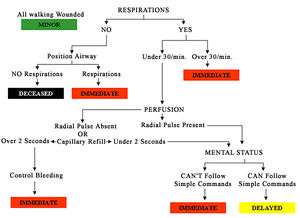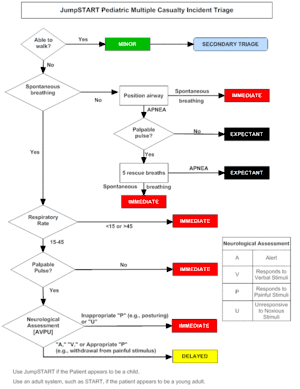Mass casualty incident triage
Background
- Used by first responders to quickly classify victims during a mass casualty incident (MCI) based on the severity of their injury
- Unlike standard medical triage, MCI triage is more utilitarian (i.e. the greatest good for the greatest number of people)
- Multiple triage systems exist, however evidence regarding their effectiveness is lacking[1]
- In an effort to update and standardize MCI triage, the Model Uniform Core Criteria (MUCC) were created as a national guideline for MCI triage[2]
- These criteria have been endorsed by all major national shareholders, including NAEMSP, ACEP, ACS, NAEMT, NASEMSO, AMA, CDC, and others.
- Currently, the SALT triage system is the only one that meets the Model Uniform Core Criteria
Classifications[3]
- Walking wounded/minor (green)
- Delayed (yellow)
- Immediate (red)
- Deceased/expectant (black)
Sort, Assess, Lifesaving intervention, Treatment/Transport (SALT)
Simple Triage and Rapid Treatment (START)

START triage algorithm
Always make sure you are safe. Then speak loudly and ask people to stand up and walk towards you. People who are:
- Able to walk relocate to a certain area (minor)
- Non-ambulatory patients are then assessed
- No respirations → re-position airway
- No respirations (deceased/expectant)
- Respirations (immediate)
- Yes respirations
- >30/min (immediate)
- <30 → check perfusion
- Radial pulse absent OR capillary refill >2 seconds (immediate)
- Radial pulse present OR capillary refill <2 seconds → check mental status
- Unable to follow simple commands (immediate)
- Follows simple commands (delayed)
- No respirations → re-position airway
JumpSTART (Pediatric Patients)

JumpSTART triage algorithm
- Able to walk relocate to a certain area (minor)
- Non-ambulatory patients are then assessed
- No respirations → re-position airway
- Respirations (immediate)
- No respirations → check pulse
- No pulse (deceased/expectant)
- Yes pulse → 5 rescue breaths
- Still no respirations (deceased/expectant)
- Respirations (immediate)
- Yes respirations
- <15 or >45/min (immediate)
- 15-45/min → check perfusion
- Pulse absent or CRT >2 seconds
- Control bleeding (immediate)
- Pulse present or CRT <2 seconds → check mental status
- Inappropriate (immediate)
- Appropriate (delayed)
- Pulse absent or CRT >2 seconds
- No respirations → re-position airway
Secondary Assessment of Victim Endpoint (SAVE)
- Applies after patients have been triaged with START/jumpStart
- Designed for appropriation of limited resources for most gain in immediate on-scene care situations
- Three categories:
- Those who will die regardless of care
- Those who will survive whether or not they receive care
- Those who will benefit from limited immediate field interventions
See also
- Mass casualty incidents
- Combat triage
Video
START_WIDGET820456e11d9f48a5-0END_WIDGET
References
- Culley JM, Svendsen E. A review of the literature on the validity of mass casualty triage systems with a focus on chemical exposures. American journal of disaster medicine. 2014;9(2):137-150. doi:10.5055/ajdm.2014.0150.
- Model uniform core criteria for mass casualty triage. Disaster Med Public Health Prep. 2011;5(2):125-8.
- Lerner EB, Schwartz RB, Coule PL, et al. "Mass Casualty Triage: An Evaluation of the Data and Development of a Proposed National Guideline." Disaster Medicine and Public Health Preparedness 2(Suppl. 1) 2008, pp S25-S34.
This article is issued from
Wikem.
The text is licensed under Creative
Commons - Attribution - Sharealike.
Additional terms may apply for the media files.